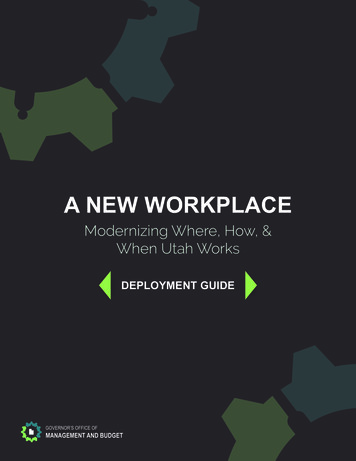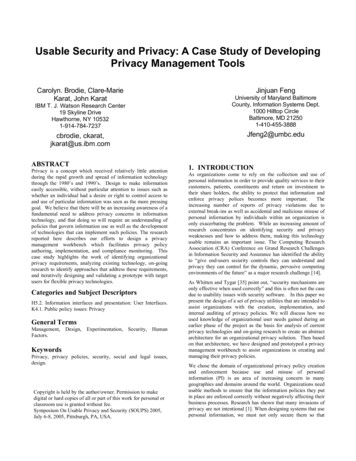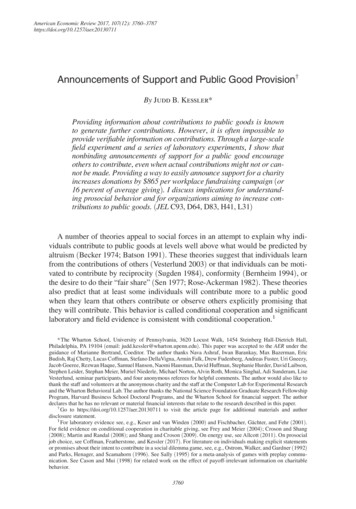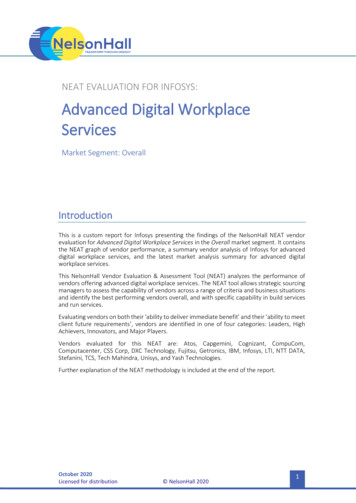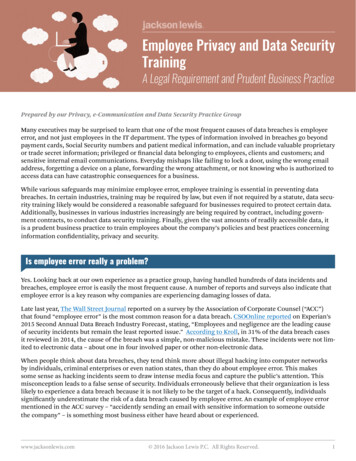
Transcription
Employee Privacy and Data SecurityTrainingA Legal Requirement and Prudent Business PracticePrepared by our Privacy, e-Communication and Data Security Practice GroupMany executives may be surprised to learn that one of the most frequent causes of data breaches is employeeerror, and not just employees in the IT department. The types of information involved in breaches go beyondpayment cards, Social Security numbers and patient medical information, and can include valuable proprietaryor trade secret information; privileged or financial data belonging to employees, clients and customers; andsensitive internal email communications. Everyday mishaps like failing to lock a door, using the wrong emailaddress, forgetting a device on a plane, forwarding the wrong attachment, or not knowing who is authorized toaccess data can have catastrophic consequences for a business.While various safeguards may minimize employee error, employee training is essential in preventing databreaches. In certain industries, training may be required by law, but even if not required by a statute, data security training likely would be considered a reasonable safeguard for businesses required to protect certain data.Additionally, businesses in various industries increasingly are being required by contract, including government contracts, to conduct data security training. Finally, given the vast amounts of readily accessible data, itis a prudent business practice to train employees about the company’s policies and best practices concerninginformation confidentiality, privacy and security.Is employee error really a problem?Yes. Looking back at our own experience as a practice group, having handled hundreds of data incidents andbreaches, employee error is easily the most frequent cause. A number of reports and surveys also indicate thatemployee error is a key reason why companies are experiencing damaging losses of data.Late last year, The Wall Street Journal reported on a survey by the Association of Corporate Counsel (“ACC”)that found “employee error” is the most common reason for a data breach. CSOOnline reported on Experian’s2015 Second Annual Data Breach Industry Forecast, stating, “Employees and negligence are the leading causeof security incidents but remain the least reported issue.” According to Kroll, in 31% of the data breach casesit reviewed in 2014, the cause of the breach was a simple, non-malicious mistake. These incidents were not limited to electronic data – about one in four involved paper or other non-electronic data.When people think about data breaches, they tend think more about illegal hacking into computer networksby individuals, criminal enterprises or even nation states, than they do about employee error. This makessome sense as hacking incidents seem to draw intense media focus and capture the public’s attention. Thismisconception leads to a false sense of security. Individuals erroneously believe that their organization is lesslikely to experience a data breach because it is not likely to be the target of a hack. Consequently, individualssignificantly underestimate the risk of a data breach caused by employee error. An example of employee errormentioned in the ACC survey – “accidently sending an email with sensitive information to someone outsidethe company” – is something most business either have heard about or experienced.www.jacksonlewis.com 2016 Jackson Lewis P.C. All Rights Reserved.1
Even if that is true, do we have a legal requirement to train employees?For many businesses, the answer is yes, but it will depend on the kind of business, where it is located and thetype of data the business maintains. Here are some examples: Healthcare providers, health plans and business associates. Certain health careproviders, health plans and their business associates are subject to the privacy and security regulationsunder the Health Insurance Portability and Accountability Act (“HIPAA”). The HIPAA privacy regulations (HIPAA Privacy Rule § 164.530(b)) require that:covered entities must train all members of its workforce as necessary and appropriate for the membersof the workforce to carry out their functions.The HIPAA security regulations (Security Rule § 164.308(a)(5)) require covered entities to:[i]mplement a security awareness and training program for all members of its workforce [includingmanagement].So, all covered healthcare providers, such as hospitals, physician practices, dental offices, nursing homes, andhome healthcare providers, have a regulatory requirement to train their workforce members. These requirements also apply to business associates of these covered entities, including accounting firms, consultants,brokers, law firms and medical billing companies.The training requirement also extends to certain employer-sponsored group health plans. Many employerssponsor some form of a self-funded health plan, such as a self-funded plan that meets the minimum value requirements for purposes of the Affordable Care Act, or a health flexible spending arrangement. Employees whohandle protected health information in the course of administering these plans must be trained. Financial Institutions. As one of the most heavily regulated industries in the United States andglobally, financial services organizations are subject to a wide range of data privacy and security requirements given the critical nature of the data they use, receive, maintain and disclose. These requirements include employee training:Safeguards Rule. Under the Gramm-Leach-Bliley Act (‘‘GLBA’’) and pursuant to regulations issued bythe Federal Trade Commission (‘‘FTC’’), certain financial institutions are required to develop administrative, technical and physical safeguards to protect customer information (known as the “SafeguardsRule”). Financial institutions generally include organizations such as lenders, financial advisors, loanbrokers and servicers, collection agencies, tax preparers and real estate settlement services that havecustomer information, whether collected from their own customers or received from other financialinstitutions.Section 314.4 of the Safeguards Rule requires financial institutions to assess and address the risks tocustomer information in all areas of their operations, including employee management and training. FTCguidance for compliance with the Safeguards Rule lists a number of steps financial institutions shouldtake, including “[t]raining employees to take basic steps to maintain the security, confidentiality, andintegrity of customer information.”Red Flags Rule. The Fair and Accurate Credit Transactions Act (“FACT Act”) requires certain federalagencies to direct financial institutions and creditors to do more to detect, prevent and mitigate identity theft. These rules apply to a broad list of businesses – “financial institutions” and “creditors” with“covered accounts.” For example, a “creditor” is defined non-exhaustively to include “lenders such asbanks, finance companies, automobile dealers, mortgage brokers, utility companies and telecommuni-www.jacksonlewis.com 2016 Jackson Lewis P.C. All Rights Reserved.2
cations companies.” And, covered accounts include any account for which there is a foreseeable risk ofidentity theft.The set of rules that followed became known as the “Red Flags” rule, which requires these covered entities to adopt programs designed to detect, prevent and mitigate identity theft. To administer the program in compliance with the regulation, the organization must “[t]rain staff, as necessary, to effectivelyimplement the Program.” See, e.g., 16 CFR § 681.2(e)(3).FDIC Guidelines. The Federal Deposit Insurance Corporation (“FDIC”) applies the Interagency Guidelines Establishing Information Security Standards (“Guidelines”) that provide standards for developingand implementing administrative, technical and physical safeguards to protect the security, confidentiality and integrity of customer information. The Guidelines apply to depository institutions insuredby the FDIC, such as banks, state savings associations, insured state branches of foreign banks andany subsidiaries of such entities (other than brokers, dealers, persons providing insurance, investmentcompanies and investment advisers). Under these Guidelines, each institution shall “[t]rain staff toimplement the bank’s information security program.”Regulation S-P. GLBA also directed the Securities and Exchange Commission to establish appropriatestandards to protect customer information. These rules, known as “Regulation S-P,” apply to investment advisers registered with the Commission, brokers, dealers and investment companies subject tothe Commission’s jurisdiction. Under these rules, these entities:must adopt policies and procedures that address administrative, technical, and physical safeguards forthe protection of customer records and information.reasonably designed to:(a) Insure the security and confidentiality of customer records and information;(b) Protect against any anticipated threats or hazards to the security or integrity of customer recordsand information; and(c) Protect against unauthorized access to or use of customer records or information that couldresult in substantial harm or inconvenience to any customer.In Notice 05-49, the National Association of Securities Dealers (“NASD”) (now known as the “FinancialIndustry Regulatory Authority,” or “FINRA”) reminded its members about the need to comply with Regulation S-P. It stated, in part, that although there is no “one-size-fits-all” policy or procedure to whichmembers must comply, members’ policies and procedures should “at a minimum” include: “providingadequate training to employees regarding the use of available technology and the steps employeesshould take to ensure that customer records and information are kept confidential.” Federal Contractors. Under the Federal Information Security Management Act (“FISMA”),certain federal agencies are required to develop, document and implement an agency-wide programto provide information security for the information and information systems that support the operations and assets of the agency, including those provided or managed by another agency, contractor or othersource. Specifically, under 44 U.S.C. § 3544(b)(4):Each agency shall develop, document, and implement an agency-wide information security program toprovide information security for the information and information systems that support the operationsand assets of the agency, including those provided or managed by another agency, contractor, or othersource, that includes security awareness training to inform personnel, including contractors andother users of information systems that support the operations and assets of the agency.www.jacksonlewis.com 2016 Jackson Lewis P.C. All Rights Reserved.3
Educational Agencies and Institutions. In general, educational agencies and institutionsreceiving funding from the federal Department of Education must comply with the Family EducationalRights and Privacy Act (“FERPA”). The law and its implementing regulations address the rights parentsand students have to students’ files at covered agencies and institutions. Questions concerning theright to access, modify or disclose student records can be challenging. Thus, training is a critical component for any privacy and security compliance program in this sector to ensure that a school’s administrators, faculty and staff members are complying with FERPA. State Law Mandates. Although there is not yet a universally applicable federal data security statutein the United States, a number of states have required businesses and other entities operating in thestate or maintaining personal information about state residents to have safeguards in place to protectthat information. In some cases, training is an express requirement, in others states, it is expected as a“reasonable safeguard.”California. California’s information security statute (California Civil Code § 1798.81.5) provides thatbusinesses that collect personal information on California residents must use “reasonable securityprocedures and practices appropriate to the nature of the information, to protect the personal information from unauthorized access, destruction, use, modification or disclosure.” Many wondered: what arethose “reasonable security procedures and practices”? A recent report by California’s Attorney Generalhelps to clarify this standard. In the report, Attorney General Kamala Harris states that the failure tocomply with the 20 controls set forth in the Center for Internet Security’s Critical Security Controls“constitutes a lack of reasonable security.” One of those 20 controls is to provide security training toemployees and vendors with access to systems containing personal information.Massachusetts. Under comprehensive data security regulations that apply to businesses that maintainpersonal information of Massachusetts residents, businesses must maintain a written informationsecurity program (“WISP”). A WISP must include: “[e]ducation and training of employees on the properuse of the computer security system and the importance of personal information security.” Data Security Reg. 201 CMR § 17.04(8).Oregon. Oregon also requires certain businesses to maintain a WISP. The WISP must include administrative safeguards under which the business: “[t]rains and manages employees in the security programpractices and procedures.” ORS § 646A.622(d)(A)(iv).Texas. In Texas, certain entities that engage in the practice of assembling, collecting, analyzing, using,evaluating, storing or transmitting protected health information are subject to a set of HIPAA-like rulesto protect that protected health information. Under that law, “[e]ach covered entity shall provide training to employees necessary and appropriate for the employees to carry out the employees’ duties forthe covered entity.” Texas Health and Safety Code § 181.101.General Safeguard Requirements. Like California, a number of other states impose general requirements on businesses to safeguard the personal information they maintain. In general, those statesrequire businesses to maintain “reasonable safeguards” to protect personal information of state residents. These states include, without limitation, Connecticut, Florida, and Maryland. Based on the express statutory requirements and other data security standards discussed above, any set of reasonablesafeguards should include data security training for employees. Payment Card Industry Data Security Standards (“PCI DSS”). Businesses that acceptcredit or debit cards as payment for goods and services will have certain obligations under PCI DSSstandards. The major card brands (e.g., Visa, MasterCard, American Express and Discover) maintainthese standards, which are administered by the Payment Card Industry Security Standards Council. InOctober 2014, the Council published “Best Practices for Implementing a Security Awareness ProgramConcerning PCI DSS Requirement 12.6,” which states:www.jacksonlewis.com 2016 Jackson Lewis P.C. All Rights Reserved.4
[A] formal security awareness program must be in place. Security awareness should be conductedas an on-going program to ensure that training and knowledge is not just delivered as an annual activity, rather it is used to maintain a high level of security awareness on a daily basis.Our Company does not maintain personal information, and our employee data is securein our HR Department, so training does not seem necessary in our business.There are at least two things wrong with this statement.First, personal information is not the only information that a business might want to protect. Many companiesmaintain proprietary and confidential business information that, if shared outside the organization (or withthe wrong people inside the organization), could cause it substantial harm. A company’s business partners andcustomers might obligate it to maintain safeguards to protect the information the business partner or customer shares with the company. Training might be expected to be included in these safeguards, it may even beexpressly stated in the services agreement.Second, certain employee information is personal information and may be subject to some of the requirementsoutlined above. For example, the Massachusetts data security regulations apply to customer and employeepersonal information, and the California Attorney General’s report suggests a similar interpretation in thatstate. With the growing number of data breaches affecting employees and increasing concerns about privacy, federal and state agencies regulating employment practices seem to be moving in a direction of requiringgreater security over employee data, which includes training. Consider the following statement from the recentEqual Employment Opportunity Commission proposed regulations under the Americans with Disabilities Act(“ADA”) concerning wellness programs:Employers and wellness program providers must take steps to protect the confidentiality of employeemedical information provided as part of an employee health program. Some of the following steps maybe required by law; others may be best practices. Proper training of individuals who handle medicalinformation in the requirements of the HIPAA Rules, the ADA, and any other applicable privacylaws is critical.What should a privacy and data security training program look like?There are a myriad of ways to design a training program to create awareness and build a culture ofprivacy and security in an organization. Key issues organizations should consider when designing atraining program include: Who should design and implement the program? If the organization has a privacy officer,this might be a good choice, but certainly not the only one. However, there should be an individualor department responsible to maintaining the program. Who should be trained? In general, this should include workforce members with access to theinformation the organization desires to safeguard. Interns, volunteers and other non-traditionalcategories of workers should not be excluded. However, even unauthorized employees may get access to that information, inadvertently perhaps, and may need to be made aware of certain compa-www.jacksonlewis.com 2016 Jackson Lewis P.C. All Rights Reserved.5
ny protocols, such as how to report a data breach. Who should conduct the training? Organizations may conduct training in-house, outsource it, or a combination of both. When performed in-house, the person selected to deliver thetraining might depend on the information or safeguards being covered. For example, if the safeguards at issue relate to information obtained by call center representatives, the call center manager might be a good choice to deliver the training. It is not necessary, however, that a member ofthe IT, HR or Legal departments deliver the training, or that it be a person with technical IT knowledge. But, the ability to convey specific information about company requirements, legal mandatesand use of technology to maximize security is certainly helpful. What should the training cover? Again, the substance of the training will depend on theorganization, the data at issue, the audience and other factors. In general, training should coversome basic issues, such as what is confidential or personal information or what is a data breach.However, training programs can be significantly enhanced when they use real situations that participants in the program can relate to and apply in their jobs. When and how often? Basic privacy and security training should be provided before an individual obtains access to confidential or personal information. At a minimum, the principles should beconveyed at least annually thereafter. Training also may be needed after changes in policies; followingincreases in levels of access or sensitivity of information; to react to changes in technology; and following a security incident and other situations, such as a merger or acquisition. How should training be delivered? There are many ways to deliver a consistent messageabout data security throughout an organization. These include policies, notices, newsletters, intranet dashboard, in-person sessions, online courses, videos, testing, tabletop exercises, employeeresource groups (“ERGs”) or a combination of these. The ability for participants to interact and askquestions can be critically important to their understanding their responsibilities as they relate tothe particular business. Should training be documented? Yes. In some cases, such as under HIPAA, documentationis required. However, an organization will be in a much better position to defend its data privacyand security practices if it can show that it maintains a comprehensive training program. Thisgenerally means that the organization tracks the materials covered in the training and those whoattended or received the information.We did training, and employees still send the emails to wrong addresses and make othermistakes!No system of safeguards is perfect, and that includes privacy and data security safeguards. Compliance is an ongoing process, and periodic data security training is an essential component of anyorganization’s data security compliance efforts. Through periodic training, organizations reinforceawareness regarding data privacy and take steps to manage risk, avoid litigation and mitigate business exposure.www.jacksonlewis.com 2016 Jackson Lewis P.C. All Rights Reserved.6
For additional information, please contact:Joe Lazzarotti, Esq., CIPPPrivacy, e-Communication and Data Security Practice Group LeaderPrincipal Morristown, NJ Office973-451-6363 lazzarottij@jacksonlewis.comThis article provides general information regarding its subject and explicitly may not be construed as providing any individualized advice concerningparticular circumstances. Persons needing advice concerning particular circumstances must consult counsel concerning those circumstances.www.jacksonlewis.com 2016 Jackson Lewis P.C. All Rights Reserved.7
that found "employee error" is the most common reason for a data breach. CSOOnline reported on Experian's 2015 Second Annual Data Breach Industry Forecast, stating, "Employees and negligence are the leading cause of security incidents but remain the least reported issue." According to Kroll, in 31% of the data breach cases
